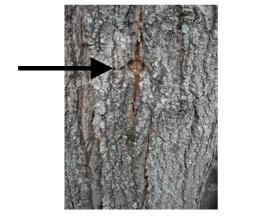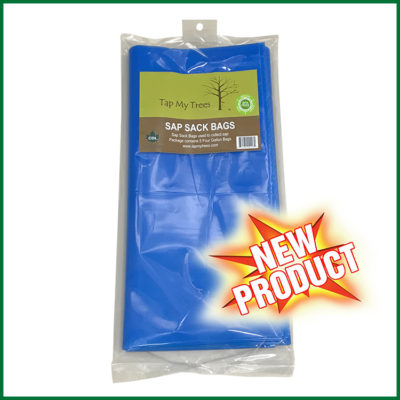- 3 Lids: Lids (plastic or metal, depending upon the kit ordered) prevent rain, snow, and foreign material from entering the bucket.
- 3 Buckets : Bucket (plastic or metal, depending upon the kit ordered) is used to collect the sap as it drips from the spile.
- 3 Spiles: Stainless steel spile (tap) is inserted into drilled hole to transfer sap into the bucket
- 3 Hooks: Hook is attached to spile and used to hang the bucket.
- Starter Guide: This guide provides step-by-step instructions (complete with pictures) to tap your maple trees. Includes information on how to identify your maple trees, how to tap trees, collection and storage of sap, uses for maple sap including how to make maple syrup, and frequently asked questions.
- 1 Drill Bit: 7/16 drill bit with 3/8 shank used to drill tap hole into your maple tree.
- Cheesecloth: Used to filter any solids (such as pieces of bark) when transferring sap from the collection bucket to a storage container.
- Maple Trees: At a minimum, you need access to one mature (at least 12 inches in diameter), healthy maple tree. Many different types of maple trees can be tapped to collect sap, including Sugar, Black, Red, and Silver Maples.
- Drill: A cordless drill is preferable, but a corded electric drill can be used with a properly insulated extension cord (long enough to reach the tree).
- Hammer: A hammer is used to gently tap the spile into the tap hole.
- Pliers: Pliers are used to remove the tap from the tree once the sap season is over.
- Storage Containers: Food grade storage containers are used to store your collected sap. Clean plastic milk jugs or juice containers may be used. You can also use food grade 5 gallon buckets. Your local deli or donut shop may provide these free of charge as they often receive their ingredients in such containers.
- Sap Processing Equipment: Depending upon how you decide to utilize your sap, additional equipment may be needed. For example, if you would like to make maple syrup, additional equipment is required. For small scale production, you can generally use items already available at home (refer to Collect Sap & Make Syrup section for details on making maple syrup).
Please refer to the Our Policies page on this site.
Tapping a tree does create a wound, but it is a wound from which the tree can readily recover and does not endanger the health of the tree. Commercial syrup producers are able to tap trees for decades without adversely affecting the health of the tree. A vigorous tree will heal, or grow over, a tap hole in one year. It may take other trees up to 3 years to grow over a tap hole. Here is an example of a tap hole after one year of recovery:

Maple sap is a clear, water like liquid captured when a maple tree is tapped. Maple syrup is produced by boiling water from the maple sap, concentrating it into a sweet syrup.
Sugar content depends upon many variables, including the type of tree, weather conditions, and if the sap is collected early or late in the flow season. The sugar content in the sap of a Sugar Maple tree can fluctuate between 1.5% and 2.5%.
The general rule of thumb is that it takes 40 parts maple sap to produce 1 part maple syrup. This translates into 40 gallons of sap to produce 1 gallon or syrup (or 10 gallons of sap for one quart of syrup). This estimate is dependent on the sugar content of your sap.
This is dependent upon many factors, but you can generally expect to collect 5 – 15 gallons of sap per tap per season.
Sap flow is caused by pressure difference within the tree when the temperature fluctuates. Nighttime temperatures below freezing and daytime temperatures above freezing create pressure conditions ideal for sap flow.
A maple tree should be at least 12 inches in diameter before tapping it. Larger trees can support multiple taps. For example, trees 21-27 inches in diameter can support 2 taps and trees greater than 27 inches in diameter can support 3 taps.
While this guide focuses on maple trees, other types of trees can be tapped. For example, Birch and Walnut trees can be tapped and will yield a sweet sap. These trees are not generally used in commercial production of syrup because the sugar content is lower, which would result in higher expenses. Alaska, where maple trees do not grow, has a thriving Birch sap industry.
Different regions grade maple syrup differently. Within the US, there are slight differences in grading standards, but between the US and Canada, the grades are substantially different. The US grading system contains the following grades:
- Grade A Light Amber: A light amber color, with a light and mild maple flavor.
- Grade A Medium Amber: A medium amber color, with a bit more maple flavor. This is the most popular grade for table use.
- Grade A Dark Amber: A dark amber color, with a strong maple flavor.
- Grade B: Dark in color, generally used for cooking and baking.
The grades correspond to the point in the season the syrup was produced. Grade A Light Amber utilizes sap from the earliest point in the season and Grade B from the latest point in the season.
These products are not considered “real” maple syrup in the sense they are not produced by boiling maple sap to yield syrup. They are generally sweetened with corn syrup or other sweeteners and flavored.
It is well documented that native Indians in the United States and Canada were the first producers of maple products. Native Indians were more likely to either drink the sap or make maple sugar products, as there was no easy way to store a liquid syrup. Early European settlers learned maple sap collection and processing skills from these native Indians. Over the years, the process of collecting and processing sap has been refined.
Tap My Trees LLC does sell supplies at a wholesale price to garden centers, farms, and maple sugar operations looking to resell them. The minimum order quantity is 20 units. Please send an email to info@tapmytrees.com for more details.


